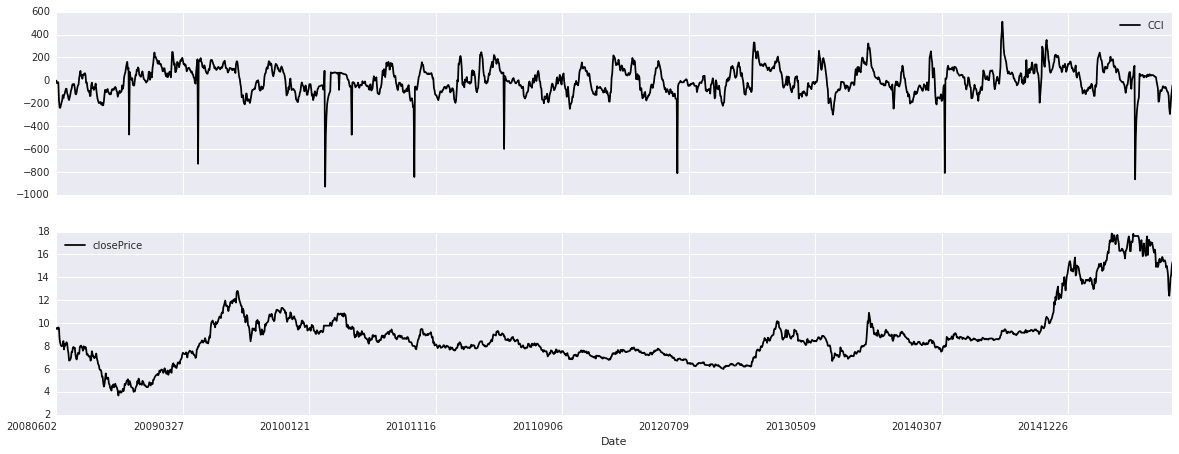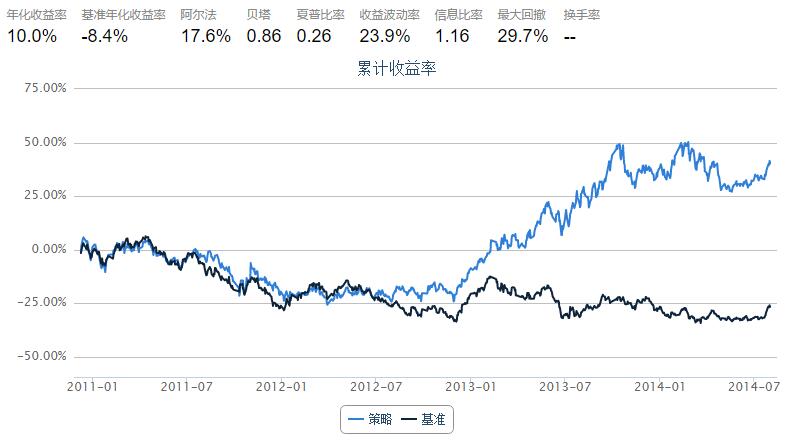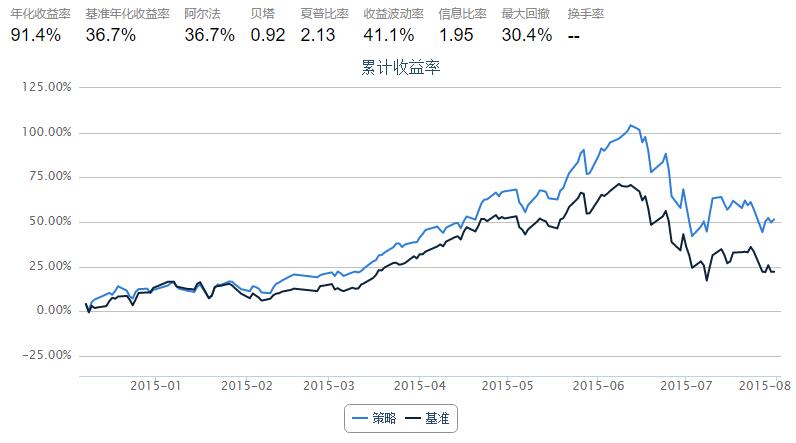4.5 CCI • CCI 顺势指标探索
一、CCI指标简介与构造
顺势指标CCI由唐纳德拉姆伯特所创,是通过测量股价的波动是否已超出其正常范围,来预测股价变化趋势的技术分析指标。计算方法参考《技术指标系列(五)——CCI的顺势而为 》。
下面描绘出CCI与股价时序图走势
def cci(stock,start_date,end_date,windows): #设置股票,起始时间,以及CCI指标多少日
import pandas as pd
import numpy as np
from CAL.PyCAL import *
Alpha = 0.015
eq_TP = {}
eq_MATP = {}
eq_meanDev = {}
eq_CCI = {}
cal = Calendar('China.SSE')
windows = '-'+str(windows)+'B'
start_date = Date.strptime(start_date,"%Y%m%d")
end_date = Date.strptime(end_date,"%Y%m%d")
timeLength = cal.bizDatesList(start_date, end_date)
for i in xrange(len(timeLength)):
begin_date = cal.advanceDate(timeLength[i],windows,BizDayConvention.Unadjusted)
begin_date =begin_date.strftime("%Y%m%d")
timeLength[i] = timeLength[i].strftime("%Y%m%d")
eq_static = DataAPI.MktEqudAdjGet(secID=stock,beginDate=begin_date,endDate=timeLength[i],field=['secID','highestPrice','lowestPrice','closePrice'],pandas="1")
for stk in stock:
try:
eq_TP[stk] = np.array(eq_static[eq_static['secID'] == stk].mean(axis=1))
eq_MATP[stk] = sum(eq_TP[stk])/len(eq_TP[stk])
eq_meanDev[stk] = sum(abs(eq_TP[stk] - eq_MATP[stk]))/len(eq_TP[stk])
eq_CCI[stk].append((eq_TP[stk][-1] - eq_MATP[stk])/(Alpha * eq_meanDev[stk]))
except:
eq_CCI[stk] = []
Date = pd.DataFrame(timeLength)
eq_CCI = pd.DataFrame(eq_CCI)
cciSeries = pd.concat([Date,eq_CCI],axis =1)
cciSeries.columns = ['Date','CCI']
return cciSeries
def cci_price_Plot(stock,start_date,end_date,windows):
cciSeries = cci(stock,start_date,end_date,windows)
closePrice = DataAPI.MktEqudAdjGet(secID=stock,beginDate=start_date,endDate=end_date,field=['closePrice'],pandas="1")
table = pd.merge(cciSeries,closePrice, left_index=True, right_index=True, how = 'inner')
return table
import pandas as pd
import numpy as np
from CAL.PyCAL import *
cal = Calendar('China.SSE')
table = cci_price_Plot(['600000.XSHG'],'20080531','20150901',30) #绘制浦发银行的CCI与股价对比图
tableDate = table.set_index('Date')
tableDate.plot(figsize=(20,8),subplots = 1)
array([<matplotlib.axes.AxesSubplot object at 0x60037d0>,
<matplotlib.axes.AxesSubplot object at 0x602fa90>], dtype=object)

二、CCI指标简单应用
选取CCI处于100和150之间,开始处于上涨趋势的股票。关于windows,我们用quick_backtest做一个简单的优化
def cci(account,N=20):
Alpha = 0.015
eq_TP = {}
eq_MATP = {}
eq_meanDev = {}
eq_CCI = {}
eq_highPrice = account.get_attribute_history('highPrice',N)
eq_closePrice = account.get_attribute_history('closePrice',N)
eq_lowPrice = account.get_attribute_history('lowPrice',N)
for stk in account.universe:
eq_TP[stk] = (eq_highPrice[stk] + eq_closePrice[stk] + eq_lowPrice[stk])/3
eq_MATP[stk] = sum(eq_TP[stk])/len(eq_TP[stk])
eq_meanDev[stk] = sum(abs(eq_TP[stk] - eq_MATP[stk]))/len(eq_TP[stk])
eq_CCI[stk] = (eq_TP[stk][-1] - eq_MATP[stk])/(Alpha * eq_meanDev[stk])
return eq_CCI
start = '2010-08-01' # 回测起始时间
end = '2014-08-01' # 回测结束时间
benchmark = 'HS300' # 策略参考标准
universe = set_universe('HS300') # 证券池,支持股票和基金
capital_base = 100000 # 起始资金
freq = 'd' # 策略类型,'d'表示日间策略使用日线回测,'m'表示日内策略使用分钟线回测
refresh_rate = 20 # 调仓频率,表示执行handle_data的时间间隔,若freq = 'd'时间间隔的单位为交易日,若freq = 'm'时间间隔为分钟
sim_params = quartz.sim_condition.env.SimulationParameters(start, end, benchmark, universe, capital_base)
idxmap_all, data_all = quartz.sim_condition.data_generator.get_daily_data(sim_params)
from CAL.PyCAL import *
import pandas as pd
import numpy as np
def initialize(account): # 初始化虚拟账户状态
pass
def handle_data(account): # 每个交易日的买入卖出指令
eq_CCI = cci(account,window)
buylist = []
for stk in account.universe:
try:
if eq_CCI[stk] > 100 and eq_CCI[stk] < 150:
buylist.append(stk)
except:
pass
for stk in account.valid_secpos:
order_to(stk, 0)
for stk in buylist[:]:
if stk not in account.universe or account.referencePrice[stk] == 0 or np.isnan(account.referencePrice[stk]):
bulist.remove(stk)
for stk in buylist:
order(stk, account.referencePortfolioValue/account.referencePrice[stk]/len(buylist))
print 'window annualized_return sharpe max_drawdown'
for window in range(10, 100, 5):
strategy = quartz.sim_condition.strategy.TradingStrategy(initialize, handle_data)
bt_test, acct = quartz.quick_backtest(sim_params, strategy, idxmap_all, data_all,refresh_rate = refresh_rate)
perf = quartz.perf_parse(bt_test, acct)
print ' {0:2d} {1:>7.4f} {2:>7.4f} {3:>7.4f}'.format(window, perf['annualized_return'], perf['sharpe'], perf['max_drawdown'])
window annualized_return sharpe max_drawdown
10 0.0186 -0.0610 0.4161
15 -0.0367 -0.2818 0.5448
20 0.0753 0.1734 0.4531
25 0.0268 -0.0254 0.3098
30 -0.0440 -0.3198 0.5640
35 0.0481 0.0599 0.4794
40 0.1117 0.3270 0.4057
45 0.0619 0.1176 0.2353
50 -0.0425 -0.3442 0.4226
55 0.0227 -0.0577 0.3355
60 0.0513 0.0540 0.4461
65 0.0860 0.1969 0.2304
70 0.0434 0.0218 0.3005
75 0.0126 -0.1176 0.3672
80 0.0891 0.2084 0.3728
85 0.1002 0.2554 0.2971
90 0.0768 0.1687 0.2710
95 0.0243 -0.0588 0.3461
from CAL.PyCAL import *
import pandas as pd
import numpy as np
start = '2010-08-01' # 回测起始时间
end = '2014-08-01' # 回测结束时间
benchmark = 'HS300' # 策略参考标准
universe = set_universe('HS300') # 证券池,支持股票和基金
capital_base = 100000 # 起始资金
freq = 'd' # 策略类型,'d'表示日间策略使用日线回测,'m'表示日内策略使用分钟线回测
refresh_rate = 20 # 调仓频率,表示执行handle_data的时间间隔,若freq = 'd'时间间隔的单位为交易日,若freq = 'm'时间间隔为分钟
def initialize(account): # 初始化虚拟账户状态
pass
def handle_data(account): # 每个交易日的买入卖出指令
eq_CCI = cci(account,85)
buylist = []
for stk in account.universe:
try:
if eq_CCI[stk] > 100 and eq_CCI[stk] < 150:
buylist.append(stk)
except:
pass
for stk in account.valid_secpos:
order_to(stk, 0)
for stk in buylist[:]:
if stk not in account.universe or account.referencePrice[stk] == 0 or np.isnan(account.referencePrice[stk]):
bulist.remove(stk)
for stk in buylist:
order(stk, account.referencePortfolioValue/account.referencePrice[stk]/len(buylist))

样本外测试
from CAL.PyCAL import *
import pandas as pd
import numpy as np
start = '2014-08-01' # 回测起始时间
end = '2015-08-01' # 回测结束时间
benchmark = 'HS300' # 策略参考标准
universe = set_universe('HS300') # 证券池,支持股票和基金
capital_base = 100000 # 起始资金
freq = 'd' # 策略类型,'d'表示日间策略使用日线回测,'m'表示日内策略使用分钟线回测
refresh_rate = 20 # 调仓频率,表示执行handle_data的时间间隔,若freq = 'd'时间间隔的单位为交易日,若freq = 'm'时间间隔为分钟
def initialize(account): # 初始化虚拟账户状态
pass
def handle_data(account): # 每个交易日的买入卖出指令
eq_CCI = cci(account,85)
buylist = []
for stk in account.universe:
try:
if eq_CCI[stk] > 100 and eq_CCI[stk] < 150:
buylist.append(stk)
except:
pass
for stk in account.valid_secpos:
order_to(stk, 0)
for stk in buylist[:]:
if stk not in account.universe or account.referencePrice[stk] == 0 or np.isnan(account.referencePrice[stk]):
bulist.remove(stk)
for stk in buylist:
order(stk, account.referencePortfolioValue/account.referencePrice[stk]/len(buylist))
